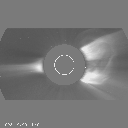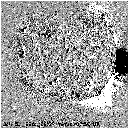

shows that it occupied almost the entire W hemisphere. At this time there were no prominent active regions on the visible hemisphere, but the remnant of AR 7978 ("last best region") were a couple of days beyond the limb at about S05. Because of the history of this region and because there was little else to do, the SXT partial-frame observations were focused on the limb at this location. Much to our surprise (see the paper by Watari et al. in the recent SOHO conference proceedings from Oslo) many fine filamentary structures shot out from behind the limb, and a major dimming occurred.

Amazing! Not only does the dimming appear right above the active region, as we already knew, but - the whole W limb lights up! Note the organized noise on the disk, with white (excess) regions to the E of black (deficit) regions as a result of solar rotation.
This is the first time such widespread effects have been seen with SXT, we believe, and probably the lack of scattered light from bright active regions contributed to this detection. In any case we have no idea just now how to explain this, unless both the northern and southern polar-crown streamers are re-forming simultaneously. But they presumably did not blow out anyway, since the CME originated near the equatorial plane even though it had a huge angular extent. So right now we're stumped.